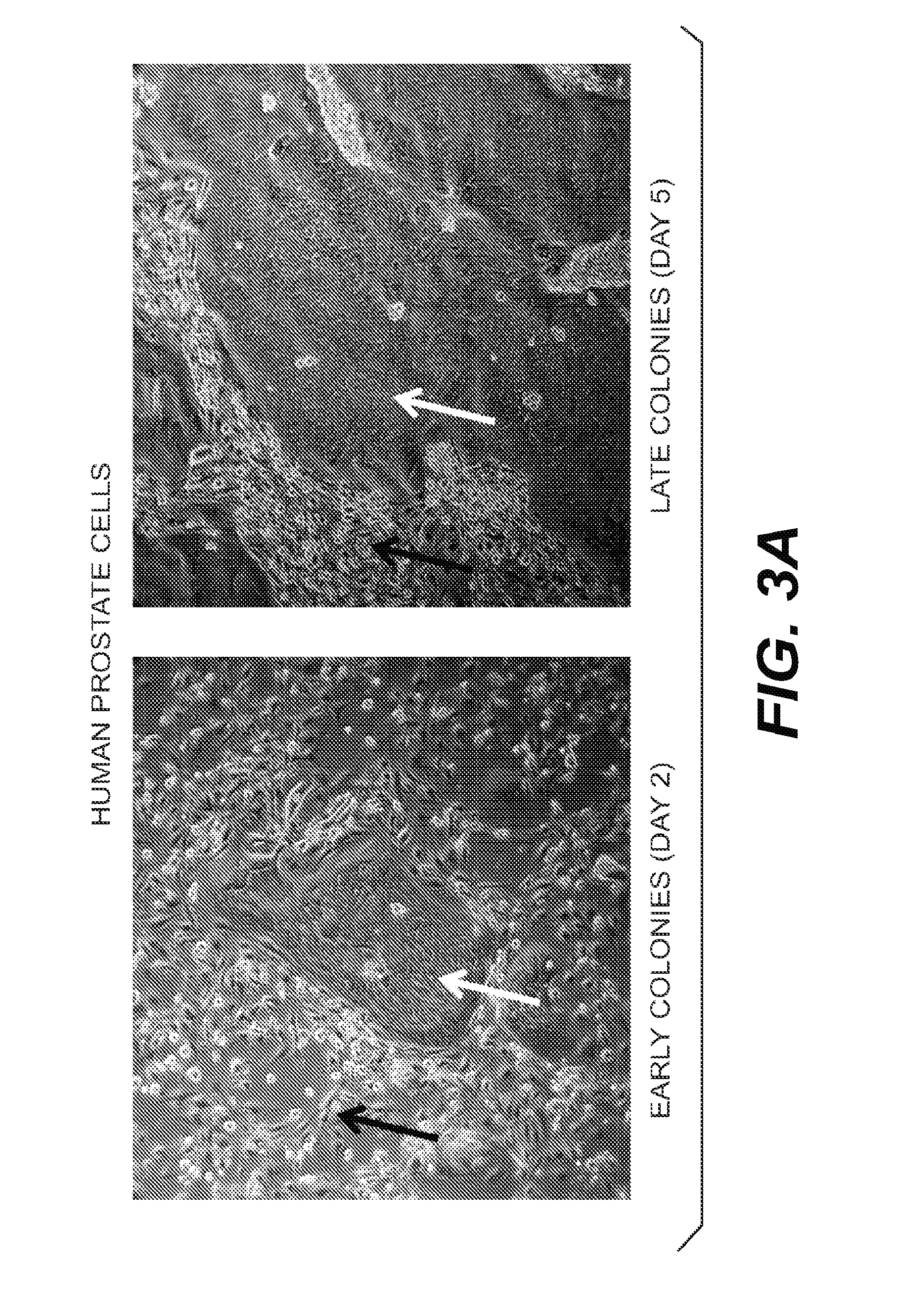Immortalization of Epithelial Cells and Methods of Use
a technology of epithelial cells and immortalization, which is applied in the field of culturing nonkeratinocyte epithelial cells, can solve the problems of difficult recovery, if possible at all, of differentiated cells such as kidney epithelial cells, insulin-producing cells, and glandular and/or hair follicle cells of the dermis, and even more difficult to maintain once taken out of their context in the body
- Summary
- Abstract
- Description
- Claims
- Application Information
AI Technical Summary
Benefits of technology
Problems solved by technology
Method used
Image
Examples
example 1
Harvesting and Culturing of Primary Human Prostate Cells (HPECs)
[0114]Normal human prostate tissues were collected with the informed consent of the patients or parents. A primary prostate cell suspension was prepared according to well-established procedures using trypsin. Briefly, prostate tissue was harvested digested with trypsin. The cells were then suspended in DMEM containing 10% serum (to neutralize the trypsin) and immediately centrifuged to isolate the pelleted cells. Such method of routine isolation and culturing of prostate epithelial cells are found in Culture of Epithelial Cells (Ian Freshney and Mary G. Freshney, Eds. Wiley-Liss, Inc.) (2nd Ed. 2002), which is incorporated by reference.
[0115]After spinning, the pellet was removed and disbursed and plated in “F medium.” F medium is prepared by mixing F-12 and DMEM (Gibco) in a 3:1 (v / v) ratio with 5% fetal bovine serum, 0.4 μg / ml hydrocortisone, 5 μg / ml insulin, 8.4 ng / ml cholera toxin, 10 ng / ml epithelial growth factor ...
example 2
Harvesting and Culturing of Primary Human Mammary Epithelial Cells (HMECs)
[0120]Normal human mammary tissues were collected with the informed consent of the patients or parents. A primary mammary cell suspension was prepared according to well-established procedures in the art. Briefly, mammary tissue was harvested and subjected digestion with a mixture of dispase and collagenase 1A, and subsequently digested with trypsin. Such method of routine isolation and culturing of mammary epithelial cells are found in Culture of Epithelial Cells (Ian Freshney and Mary G. Freshney, Eds. Wiley-Liss, Inc.) (2nd Ed. 2002), which is incorporated by reference.
[0121]After spinning, the pellet was removed and disbursed and plated in “F medium.” F medium is prepared by mixing F-12 (Gibco) in a 3:1 (v / v) ratio with 5% fetal bovine serum, 0.4 μg / ml hydrocortisone, 5 μg / ml insulin, 8.4 ng / ml cholera toxin, 10 ng / ml epithelial growth factor (EGF), 24 μg / ml adenine, 100 U / ml penicillin and 100 μg / ml strept...
example 3
Comparison of Growth Curves of HMECs and HPECs Under Various Conditions
[0125]Primary HMECs and HPECs were grown under the four different conditions noted in FIG. 2. Referring to FIG. 2, PrEGM (Lifeline Cell Technology) is a synthetic medium (“Postalife Epithelial Cell Culture Medium”) specifically designed for culturing prostate epithelial cells that does not contain serum and where the supplements are synthetic and well defined. MEGM (Lifeline Cell Technology) is a synthetic medium (“Brochialife Epithelial Cell Culture Medium”) specifically designed for culturing mammary epithelial cells that does not contain serum and where the supplements are synthetic and well defined. Feeders were the J2 mouse fibroblasts that have been gamma irradiated. The ROCK inhibitor was Y27632 at a concentration of 10 μM that was applied to the cells at initial plating and thereafter. The y-axis is population doublings and the x-axis is number of days. Media was changed every 2-3 days for all groups.
[012...
PUM
| Property | Measurement | Unit |
|---|---|---|
| concentration | aaaaa | aaaaa |
| v/v | aaaaa | aaaaa |
| temperature | aaaaa | aaaaa |
Abstract
Description
Claims
Application Information
 Login to View More
Login to View More - R&D
- Intellectual Property
- Life Sciences
- Materials
- Tech Scout
- Unparalleled Data Quality
- Higher Quality Content
- 60% Fewer Hallucinations
Browse by: Latest US Patents, China's latest patents, Technical Efficacy Thesaurus, Application Domain, Technology Topic, Popular Technical Reports.
© 2025 PatSnap. All rights reserved.Legal|Privacy policy|Modern Slavery Act Transparency Statement|Sitemap|About US| Contact US: help@patsnap.com



